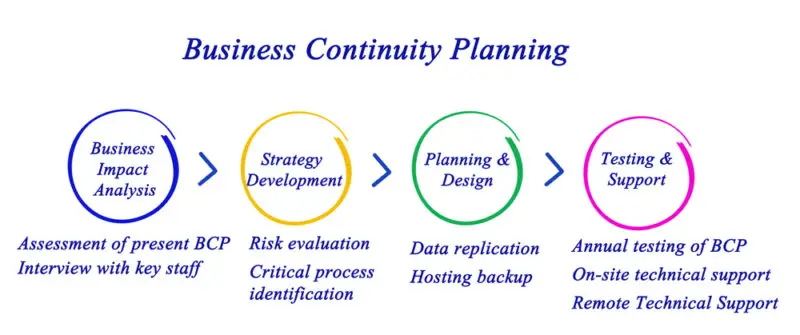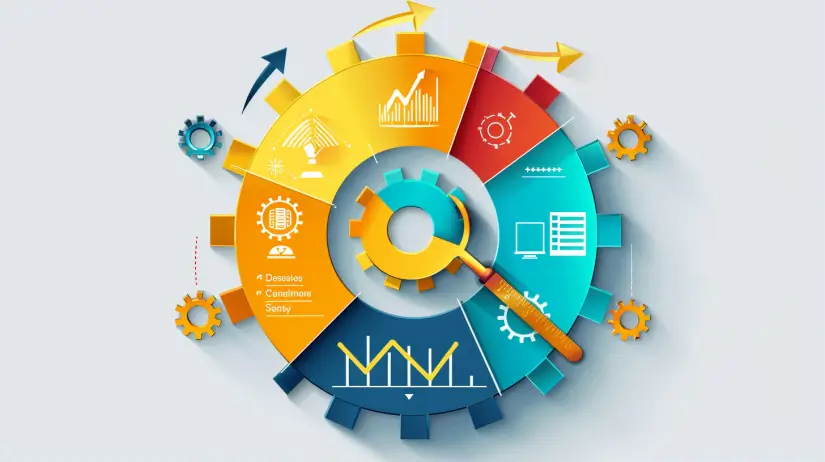The Business Continuity Management Cycle has 6 stages to help you prepare for disruptions. First the Analysis stage identifies continuity requirements and assesses the impact. Then the Design stage creates the Business Continuity Plan.
Implementation puts the plan into action and tests it. Testing and Validation evaluates preparedness through exercises and audits. Maintenance and Review keeps the plan up to date with emerging risks.
Finally Embedding Business Continuity into the Organisation puts these practices into the culture and makes you resilient. Each stage builds on the last to make you more effective in a crisis.

Summary
- The Business Continuity Management Cycle has 6 stages: Analysis, Design, Implementation, Testing and Validation, Maintenance and Review, Embedding into the Organisation.
- Stage 1: Analysis identifies continuity requirements and assesses disruption impact through Business Impact Analysis (BIA).
- Stage 2: Design creates the Business Continuity Plan (BCP) aligned to recovery time objectives (RTOs).
- Stage 3: Implementation executes the BCP, sets up incident response structures and tests strategies.
- Stage 4: Testing and Validation exercises and assesses the BCP to identify areas for improvement.
Business Continuity Planning
Business continuity planning is key to protecting your business from unexpected disruptions. This proactive approach helps you identify the potential threats, vulnerabilities and weaknesses that could impact your business.
A business continuity plan (BCP) should contain all the critical information needed to keep your critical business functions running during an unplanned event. This includes risk assessment and business impact analysis to help you understand how disruptions will impact your critical business processes.
Stage 1
In the analysis stage of business continuity management you identify your business continuity life cycle requirements through a structured process.
The Business Impact Analysis (BIA) is key to this stage as it assesses the impact of disruptions on the activities.
Business Impact Analysis
Carrying out a business impact analysis (BIA) is essential to business continuity planning. The BIA helps you identify critical business functions and the threats to those operations.
By assessing the impact of disruptions you can understand how incidents will affect revenue, expenses and company reputation. This risk analysis also provides the data needed to develop an IT disaster recovery plan including recovery time objectives (RTOs) and dependencies.
Through risk analysis stakeholders can prioritise resources for business recovery and minimise downtime during disruptions. Ultimately the BIA is the foundation for creating robust strategies that protect the core business operations so you can respond and stay stable in the face of challenges.
Stage 2: Design
In Stage 2: Design you create a comprehensive Business Continuity Plan aligned to your recovery time objectives (RTOs).
This stage uses the data from the analysis to create solutions such as diversify or replicate key processes and resources.
Business Continuity Plan
Creating a Business Continuity Plan (BCP) is a critical step to ensure you can respond to unexpected disruptions. This process involves identifying the threats such as cyber attacks or natural disasters that will impact critical functions.
A successful BCP also should contain the business processes and strategies to keep them running during a crisis. The planning process incorporates risk management principles and sets a recovery time objective so you can get back up and running quickly.
Disaster and recovery strategy is key to minimising downtime and financial loss. By addressing these key components you can create a business continuity management lifecycle that makes you more resilient to unexpected events and ultimately more sustainable in the long term.

Stage 3: Implementation
In the implementation stage you put your business continuity plans into action and meet the requirements within the timeframes set.
This stage is critical as it tests the strategies and procedures developed earlier.
Also it involves creating an incident response structure that outlines the roles, authority and skills needed to manage the incidents.
Implementing the Business Continuity Plan
Implementing key framework of the Business Continuity Plan requires coordination and buy in from all levels of the organisation.
This stage of business continuity risk management involves gathering data and defining the critical functions to keep the business running. You need to identify the threats and how to mitigate the risks.
Success depends on the quality of the business continuity plans which should contain detailed procedures for response. Defining recovery timeframes ensures resources are available when needed.
With a business continuity strategy in your computer systems in place you can manage disruptions and keep the business running. By prioritising these components you can be more resilient and adaptable in a changing world.
Stage 4: Testing and Validation
In Stage 4 of the Business Continuity Management Lifecycle testing the Business Continuity Plan is key.
Organisations carry out various exercises, drills and surveys to test their readiness and identify gaps in the plans.
Regular validation ensures the arrangements remain relevant and aligned to the objectives.
Testing the Business Continuity Plan
Testing the Business Continuity Plan is key to ensure you can respond effectively to disruptions. By testing the plan through tabletop exercises, walk-throughs and emergency simulations you can test the business continuity programme.
This process validates that the BC procedures align to the business continuity objectives. The goal is to minimise recovery time and keep processes running during unexpected events.
Regular testing not only reinforces the organisation’s readiness but also highlights the areas for improvement. Ultimately this stage is critical to ensure you are ready to face the challenges and respond quickly when it matters most.
Stage 5: Maintenance and Review
In Stage 5 you review and update the business continuity plan to ensure it remains relevant.
This ongoing risk take process covers new risks and changes in the external environment that will impact the business.
Review and Update
Reviewing and updating business continuity plans regularly is key to keeping them effective and relevant. This stage of the business continuity lifecycle involves identifying the risks and ensuring the plans align to the organisation’s framework.
You should have a cadence for these activities including regular meetings with stakeholders to discuss responsibilities and any major changes to the plans.
By first identifying potential threats, emerging technology and its implications you can make informed updates.
You should revisit Business Impact Analyses (BIA) regularly to ensure they are up to date and responsive to changing threats.
These proactive steps will keep you prepared and resilient and ultimately protect your business and resources in the event of a crisis.
Stage 6: Business Continuity in the Organisation
In Stage 6 business continuity in the organisation is key to being resilient.
This means changing the culture and mindset of stakeholders through ongoing communication, training and awareness activities.
Business Continuity in Organisational Culture
Business continuity in an organisation’s culture is critical for long term resilience and operational effectiveness.
Effective business continuity planning (BCP) requires active communication and engagement from all levels especially senior leadership.
These leaders must have clear business continuity objectives and arrangements that align to the organisation’s values and objectives.
By incorporating crisis communication into daily operations you can manage expectations, do risk assessment reduce confusion and maintain operational integrity during disruptions. This proactive approach means employees know their roles in business continuity.
Good planning and open communication creates an organisational culture where business continuity is everyone’s responsibility and ultimately a more resilient organisation that can navigate challenges and run the business.
Stage 7: Continuous Improvement
In Stage 7: Continuous Improvement you review the lessons learned from exercising the business continuity plans and take action to improve them.
This includes updating the inputs and plans at least annually or more frequently if major changes occur.
Business Continuity Management Lifecycle
While organisations have a BCMS in place they must also prioritise continuous improvement to be resilient.
The business continuity lifecycle requires organisations to adapt and refine their approach to changing threats including natural disasters.
By reviewing trends in nonconformities and corrective actions you can take key steps to strengthen your organization and BCM lifecycle. This proactive approach will help you develop and maintain your business continuity arrangements.
So they can recover and keep providing critical services during disruptions.
Continuous improvement means businesses can respond to the unexpected and improve overall operational resilience and stay ahead in an uncertain world.
FAQ
Which Industries Benefit From Business Continuity Planning?
Many industries such as healthcare, finance and manufacturing benefit from business continuity planning. They keep operational resilience, protect assets and customer trust and can navigate disruptions and recover quickly from unexpected or disruptive events.
How Often Should the Business Continuity Plan Be Reviewed?
The business continuity plan should be reviewed at least annually or more frequently if major changes occur. Regular reviews will ensure it’s working and aligned to changing risks, technologies and organisational objectives and ultimately improve resilience and readiness.
What Are the Common Obstacles to Business Continuity Planning?
Implementing a business continuity plan can be challenging with employee resistance, insufficient resources, no training and unclear communication. Organisations struggle to balance preparedness with day to day operations and have gaps in execution and understanding.
Who Should Be Part of the Business Continuity Planning Process?
Key stakeholders such as management, IT, operations and human resources must be involved in business continuity planning. Their different perspectives will ensure the development of comprehensive strategies to address the risks and overall organisational resilience during disruptions.

What Tools Can Help With Business Continuity?
Various tools can help with your business continuity strategy. Risk assessment software, communication platforms for team collaboration and incident response apps will streamline the process so you can prepare for and recover from unexpected disruptions and emergencies.

Chris Ekai is a Risk Management expert with over 10 years of experience in the field. He has a Master’s(MSc) degree in Risk Management from University of Portsmouth and is a CPA and Finance professional. He currently works as a Content Manager at Risk Publishing, writing about Enterprise Risk Management, Business Continuity Management and Project Management.

